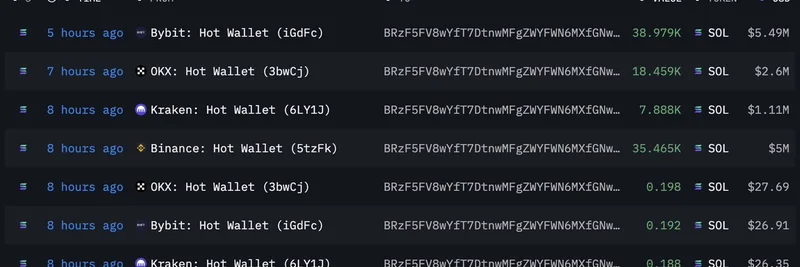Ethereum Day (ETHDAY) is a newly launched meme-style token on the Ethereum network, using the contract address 0xb35832e4556598ac92c6b2c7a8292f2dd92d7914. Despite some confusion in the community, this specific contract does not appear on BscScan and is not deployed on the BNB Chain. If you’re exploring ETHDAY, here’s a clear, practical rundown of what’s known so far, plus how to research the contract and trade safely.
Quick token snapshot
- Name: Ethereum Day (ETHDAY)
- Contract: 0xb35832e4556598ac92c6b2c7a8292f2dd92d7914
- Network: Ethereum
- Nature: Early-stage, trending meme token
- Market cap (as of Nov 16, 2025): ~$67,741
- 24h volume (as of Nov 16, 2025): ~$15,036
- Liquidity (as of Nov 16, 2025): ~$20,380
- Reported tax: 0% on buys/sells
- Pair age (as of Nov 16, 2025): ~3 hours at observation
These figures reflect a very fresh launch. Early liquidity can change quickly, and data may be outdated by the time you read this—always verify in real time before acting.
Contract risk: the blacklist function
One of the most important findings is the presence of a blacklist function in the ETHDAY contract. In simple terms, a blacklist function allows the token’s controllers to block specific wallet addresses from transacting—most critically, from selling.
- Why it matters: If a wallet gets blacklisted, the holder may be unable to sell their tokens, potentially resulting in a total loss of funds.
- How to spot it: On Etherscan, look for functions with names like “blacklist,” “setBlacklist,” or code that enforces transfer restrictions tied to a list of addresses.
- Practical takeaway: Treat blacklist-enabled contracts as high risk. If the owner retains control and the function is active, your exit path can be restricted at any time.
Market context and liquidity
With a pair less than a day old at the time of observation and modest liquidity (~$20k), ETHDAY sits firmly in the “early, volatile” category common to meme tokens. Even with a reported 0% tax:
- Slippage can still be meaningful due to thin liquidity and fast-moving price action.
- Early holders and bots can dominate price moves within minutes.
- Liquidity stability depends on whether LP tokens are locked, who controls them, and whether the owner can pull or move liquidity.
Where to track and trade ETHDAY
If you plan to monitor or trade, use multiple sources and be cautious:
- GMGN.AI dedicated token page: https://gmgn.ai/eth/token/fV1R5sZ5_0xb35832e4556598ac92c6b2c7a8292f2dd92d7914
- Uniswap (DEX for swapping on Ethereum): https://app.uniswap.org
- Etherscan (contract and holder analytics): https://etherscan.io/address/0xb35832e4556598ac92c6b2c7a8292f2dd92d7914
- DexTools (pair explorer and live charts): https://www.dextools.io
Tip: Always confirm you’re interacting with the exact contract address above before swapping. Impersonation tokens are common in early meme launches.
What GMGN.AI adds to your research toolkit
GMGN.AI focuses on speed and depth for meme markets across Ethereum and other chains. It’s helpful for:
- Smart money tracking: See how top wallets are positioning.
- Real-time analytics: Follow new pairs, volume surges, and holder changes.
- Automated trading: Advanced users can automate strategies via a linked Telegram bot (https://t.me/gmgnaibot?start=i_fV1R5sZ5).
- Security checks: Flags for high taxes, transfer restrictions, and honeypot-like behavior.
Use GMGN.AI alongside Uniswap, Etherscan, and DexTools to triangulate data and reduce blind spots.
How to do quick due diligence (5-minute checklist)
- Verify chain and address
- Confirm ETHDAY is on Ethereum and you’re using the exact contract: Etherscan.
- Scan the contract
- Look for blacklist-related functions and owner-only controls (e.g., “onlyOwner” modifiers, trading enable/disable switches).
- Check if ownership is renounced; if not, understand what permissions remain.
- Review liquidity
- Is liquidity locked? For how long? Who controls the LP tokens?
- Sudden liquidity moves often precede big price swings or exits.
- Holder distribution
- Check top holders. A few wallets controlling a large share can create outsized volatility.
- Simulate a small transaction
- Use minimal size for initial tests. If sells fail or require unusual slippage, consider stepping back.
- Monitor live behavior
Notes on naming and chain
Don’t confuse the ETHDAY token with “Ethereum Day” events or general Ethereum news cycles. ETHDAY is a specific asset with its own contract and risk profile. Also note: searches on BscScan do not show this address as a BNB Chain token; ETHDAY, at this address, is on Ethereum.
Final thoughts
ETHDAY has early traction typical of meme tokens—fast-moving price action, thin liquidity, and heightened contract risk due to a blacklist function. If you decide to engage, treat it as high risk:
- Never invest more than you can afford to lose.
- Use multiple data sources.
- Prioritize contracts without restrictive functions and with transparent liquidity practices.
Staying disciplined with research, small position sizing, and continuous monitoring is your edge in early-stage meme markets.




